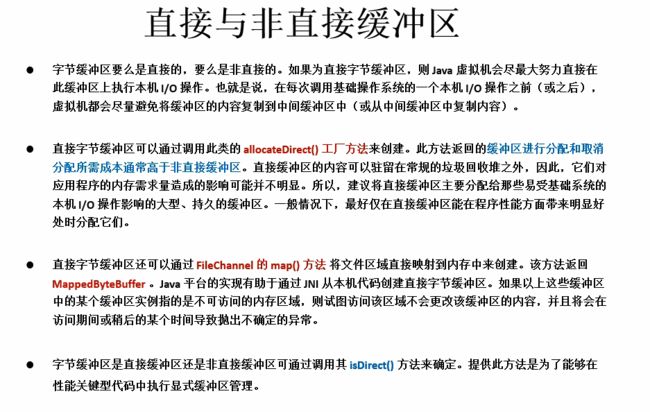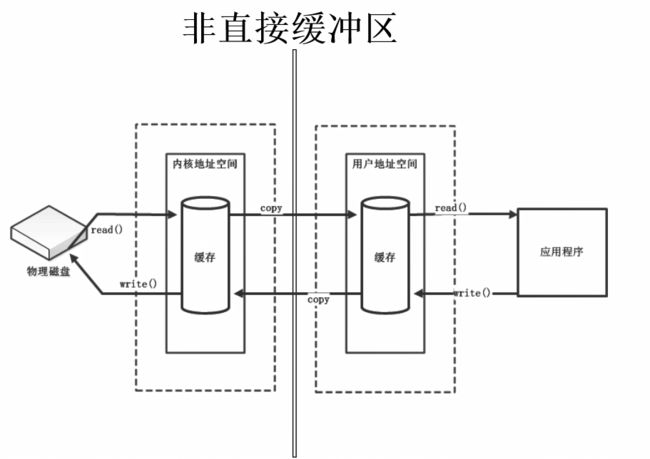Buffer 缓冲
package com.atguigu.nio;
import org.junit.Test;
import java.nio.ByteBuffer;
/*
* 一、缓冲区(Buffer):在 Java NIO 中负责数据的存取。缓冲区就是数组。用于存储不同数据类型的数据
*
* 根据数据类型不同(boolean 除外),提供了相应类型的缓冲区:
* ByteBuffer
* CharBuffer
* ShortBuffer
* IntBuffer
* LongBuffer
* FloatBuffer
* DoubleBuffer
*
* 上述缓冲区的管理方式几乎一致,通过 allocate() 获取缓冲区
*
* 二、缓冲区存取数据的两个核心方法:
* put() : 存入数据到缓冲区中
* get() : 获取缓冲区中的数据
*
* 三、缓冲区中的四个核心属性:
* capacity : 容量,表示缓冲区中最大存储数据的容量。一旦声明不能改变。
* limit : 界限,表示缓冲区中可以操作数据的大小。(limit 后数据不能进行读写)
* position : 位置,表示缓冲区中正在操作数据的位置。
*
* mark : 标记,表示记录当前 position 的位置。可以通过 reset() 恢复到 mark 的位置
*
* 0 <= mark <= position <= limit <= capacity
*
* 四、直接缓冲区与非直接缓冲区:
* 非直接缓冲区:通过 allocate() 方法分配缓冲区,将缓冲区建立在 JVM 的内存中
* 直接缓冲区:通过 allocateDirect() 方法分配直接缓冲区,将缓冲区建立在物理内存中。可以提高效率
*/
public class TestBuffer {
@Test
public void test1() {
String str = "abcde";
//1. 分配一个指定大小的缓冲区
ByteBuffer buf = ByteBuffer.allocate(1024);
System.out.println("-----------------allocate()----------------");
System.out.println(buf.position());
System.out.println(buf.limit());
System.out.println(buf.capacity());
//2. 利用 put() 存入数据到缓冲区中
buf.put(str.getBytes());
System.out.println("-----------------put()----------------");
System.out.println(buf.position());
System.out.println(buf.limit());
System.out.println(buf.capacity());
//3. 切换读取数据模式
buf.flip();
System.out.println("-----------------flip()----------------");
System.out.println(buf.position());
System.out.println(buf.limit());
System.out.println(buf.capacity());
//4. 利用 get() 读取缓冲区中的数据
byte[] dst = new byte[buf.limit()];
buf.get(dst);
System.out.println(new String(dst, 0, dst.length));
System.out.println("-----------------get()----------------");
System.out.println(buf.position());
System.out.println(buf.limit());
System.out.println(buf.capacity());
//5. rewind() : 可重复读
buf.rewind();
System.out.println("-----------------rewind()----------------");
System.out.println(buf.position());
System.out.println(buf.limit());
System.out.println(buf.capacity());
//6. clear() : 清空缓冲区. 但是缓冲区中的数据依然存在,但是处于“被遗忘”状态
buf.clear();
System.out.println("-----------------clear()----------------");
System.out.println(buf.position());
System.out.println(buf.limit());
System.out.println(buf.capacity());
System.out.println((char) buf.get());
}
@Test
public void test2() {
String str = "abcde";
ByteBuffer buf = ByteBuffer.allocate(1024);
buf.put(str.getBytes());
buf.flip();
byte[] dst = new byte[buf.limit()];
buf.get(dst, 0, 2);
System.out.println(new String(dst, 0, 2));
System.out.println(buf.position());
//mark() : 标记
buf.mark();
buf.get(dst, 2, 2);
System.out.println(new String(dst, 2, 2));
System.out.println(buf.position());
//reset() : 恢复到 mark 的位置
buf.reset();
System.out.println(buf.position());
//判断缓冲区中是否还有剩余数据
if (buf.hasRemaining()) {
//获取缓冲区中可以操作的数量
System.out.println(buf.remaining());
}
}
@Test
public void test3() {
//分配直接缓冲区
ByteBuffer buf = ByteBuffer.allocateDirect(1024);
System.out.println(buf.isDirect());
}
}
Channel通道
package com.atguigu.nio;
import org.junit.Test;
import java.io.FileInputStream;
import java.io.FileOutputStream;
import java.io.IOException;
import java.io.RandomAccessFile;
import java.nio.ByteBuffer;
import java.nio.CharBuffer;
import java.nio.MappedByteBuffer;
import java.nio.channels.FileChannel;
import java.nio.channels.FileChannel.MapMode;
import java.nio.charset.Charset;
import java.nio.charset.CharsetDecoder;
import java.nio.charset.CharsetEncoder;
import java.nio.file.Paths;
import java.nio.file.StandardOpenOption;
import java.util.Map;
import java.util.Map.Entry;
import java.util.Set;
/*
* 一、通道(Channel):用于源节点与目标节点的连接。在 Java NIO 中负责缓冲区中数据的传输。
* Channel 本身不存储数据,因此需要配合缓冲区进行传输。
*
* 二、通道的主要实现类
* java.nio.channels.Channel 接口:
* |--FileChannel
* |--SocketChannel
* |--ServerSocketChannel
* |--DatagramChannel
*
* 三、获取通道
* 1. Java 针对支持通道的类提供了 getChannel() 方法
* 本地 IO:
* FileInputStream/FileOutputStream
* RandomAccessFile
*
* 网络IO:
* Socket
* ServerSocket
* DatagramSocket
*
* 2. 在 JDK 1.7 中的 NIO.2 针对各个通道提供了静态方法 open()
* 3. 在 JDK 1.7 中的 NIO.2 的 Files 工具类的 newByteChannel()
*
* 四、通道之间的数据传输
* transferFrom()
* transferTo()
*
* 五、分散(Scatter)与聚集(Gather)
* 分散读取(Scattering Reads):将通道中的数据分散到多个缓冲区中
* 聚集写入(Gathering Writes):将多个缓冲区中的数据聚集到通道中
*
* 六、字符集:Charset
* 编码:字符串 -> 字节数组
* 解码:字节数组 -> 字符串
*
*/
public class TestChannel {
//利用通道完成文件的复制(非直接缓冲区)
@Test
public void test1() throws IOException {
long start = System.currentTimeMillis();
FileInputStream in = new FileInputStream("E:\\视频测试\\超大文件测试.zip");
FileOutputStream out = new FileOutputStream("E:\\视频测试\\2.zip");
//①获取通道
FileChannel inChannel = in.getChannel();
FileChannel outChannel = out.getChannel();
//②分配指定大小的缓冲区
ByteBuffer buf = ByteBuffer.allocate(1024);
//③将通道中的数据存入缓冲区中
while (inChannel.read(buf) != -1) {
buf.flip(); //切换读取数据的模式
//④将缓冲区中的数据写入通道中
outChannel.write(buf);
buf.clear(); //清空缓冲区
}
outChannel.close();
inChannel.close();
out.close();
in.close();
long end = System.currentTimeMillis();
System.out.println("耗费时间为:" + (end - start));
//13M大小文件 402毫秒
//10G大小文件 329945毫秒
}
//使用直接缓冲区完成文件的复制(内存映射文件)
@Test
public void test2() throws IOException {
long start = System.currentTimeMillis();
FileChannel inChannel = FileChannel.open(Paths.get("E:\\视频测试\\13M大小.mp4"), StandardOpenOption.READ);
FileChannel outChannel = FileChannel.open(Paths.get("E:\\视频测试\\3.mp4"), StandardOpenOption.WRITE, StandardOpenOption.READ, StandardOpenOption.CREATE);
//内存映射文件
MappedByteBuffer inMappedBuf = inChannel.map(MapMode.READ_ONLY, 0, inChannel.size());
MappedByteBuffer outMappedBuf = outChannel.map(MapMode.READ_WRITE, 0, inChannel.size());
//直接对缓冲区进行数据的读写操作
byte[] dst = new byte[inMappedBuf.limit()];
inMappedBuf.get(dst);
outMappedBuf.put(dst);
inChannel.close();
outChannel.close();
long end = System.currentTimeMillis();
System.out.println("耗费时间为:" + (end - start));
// 13M 大小文件 170毫秒
}
//通道之间的数据传输(直接缓冲区)
@Test
public void test3() throws IOException {
FileChannel inChannel = FileChannel.open(Paths.get("E:\\视频测试\\13M大小.mp4"), StandardOpenOption.READ);
FileChannel outChannel = FileChannel.open(Paths.get("E:\\视频测试\\3.mp4"), StandardOpenOption.WRITE, StandardOpenOption.READ, StandardOpenOption.CREATE);
// inChannel.transferTo(0, inChannel.size(), outChannel);
outChannel.transferFrom(inChannel, 0, inChannel.size());
inChannel.close();
outChannel.close();
}
//分散和聚集
@Test
public void test4() throws IOException {
RandomAccessFile raf1 = new RandomAccessFile("1.txt", "rw");
//1. 获取通道
FileChannel channel1 = raf1.getChannel();
//2. 分配指定大小的缓冲区
ByteBuffer buf1 = ByteBuffer.allocate(100);
ByteBuffer buf2 = ByteBuffer.allocate(1024);
//3. 分散读取
ByteBuffer[] bufs = {buf1, buf2};
channel1.read(bufs);
for (ByteBuffer byteBuffer : bufs) {
byteBuffer.flip();
}
System.out.println(new String(bufs[0].array(), 0, bufs[0].limit()));
System.out.println("-----------------");
System.out.println(new String(bufs[1].array(), 0, bufs[1].limit()));
//4. 聚集写入
RandomAccessFile raf2 = new RandomAccessFile("2.txt", "rw");
FileChannel channel2 = raf2.getChannel();
channel2.write(bufs);
}
@Test
public void test5() {
Map map = Charset.availableCharsets();
Set> set = map.entrySet();
for (Entry entry : set) {
System.out.println(entry.getKey() + "=" + entry.getValue());
}
}
//字符集
@org.junit.Test
public void test6() throws IOException {
Charset cs1 = Charset.forName("GBK");
//获取编码器
CharsetEncoder ce = cs1.newEncoder();
//获取解码器
CharsetDecoder cd = cs1.newDecoder();
CharBuffer cBuf = CharBuffer.allocate(1024);
cBuf.put("垃圾垃圾!");
cBuf.flip();
//编码
ByteBuffer bBuf = ce.encode(cBuf);
for (int i = 0; i < bBuf.limit(); i++) {
System.out.println(bBuf.get());
}
//解码
bBuf.flip();
CharBuffer cBuf2 = cd.decode(bBuf);
System.out.println(cBuf2.toString());
System.out.println("------------------------------------------------------");
Charset cs2 = Charset.forName("GBK");
bBuf.flip();
CharBuffer cBuf3 = cs2.decode(bBuf);
System.out.println(cBuf3.toString());
}
}
阻塞
package com.atguigu.nio;
import org.junit.Test;
import java.io.IOException;
import java.net.InetSocketAddress;
import java.nio.ByteBuffer;
import java.nio.channels.FileChannel;
import java.nio.channels.ServerSocketChannel;
import java.nio.channels.SocketChannel;
import java.nio.file.Paths;
import java.nio.file.StandardOpenOption;
/*
* 一、使用 NIO 完成网络通信的三个核心:
*
* 1. 通道(Channel):负责连接
*
* java.nio.channels.Channel 接口:
* |--SelectableChannel
* |--SocketChannel
* |--ServerSocketChannel
* |--DatagramChannel
*
* |--Pipe.SinkChannel
* |--Pipe.SourceChannel
*
* 2. 缓冲区(Buffer):负责数据的存取
*
* 3. 选择器(Selector):是 SelectableChannel 的多路复用器。用于监控 SelectableChannel 的 IO 状况
*
*/
public class TestBlockingNIO {
//客户端
@Test
public void client() throws IOException {
//1. 获取通道
SocketChannel sChannel = SocketChannel.open(new InetSocketAddress("127.0.0.1", 9898));
FileChannel inChannel = FileChannel.open(Paths.get("1.jpg"), StandardOpenOption.READ);
//2. 分配指定大小的缓冲区
ByteBuffer buf = ByteBuffer.allocate(1024);
//3. 读取本地文件,并发送到服务端
while (inChannel.read(buf) != -1) {
buf.flip();
sChannel.write(buf);
buf.clear();
}
//4. 关闭通道
inChannel.close();
sChannel.close();
}
//服务端
@Test
public void server() throws IOException {
//1. 获取通道
ServerSocketChannel ssChannel = ServerSocketChannel.open();
FileChannel outChannel = FileChannel.open(Paths.get("2.jpg"), StandardOpenOption.WRITE, StandardOpenOption.CREATE);
//2. 绑定连接
ssChannel.bind(new InetSocketAddress(9898));
//3. 获取客户端连接的通道
SocketChannel sChannel = ssChannel.accept();
//4. 分配指定大小的缓冲区
ByteBuffer buf = ByteBuffer.allocate(1024);
//5. 接收客户端的数据,并保存到本地
while (sChannel.read(buf) != -1) {
buf.flip();
outChannel.write(buf);
buf.clear();
}
//6. 关闭通道
sChannel.close();
outChannel.close();
ssChannel.close();
}
}
package com.atguigu.nio;
import java.io.IOException;
import java.net.InetSocketAddress;
import java.nio.ByteBuffer;
import java.nio.channels.FileChannel;
import java.nio.channels.ServerSocketChannel;
import java.nio.channels.SocketChannel;
import java.nio.file.Paths;
import java.nio.file.StandardOpenOption;
import org.junit.Test;
public class TestBlockingNIO2 {
//客户端
@Test
public void client() throws IOException{
SocketChannel sChannel = SocketChannel.open(new InetSocketAddress("127.0.0.1", 9898));
FileChannel inChannel = FileChannel.open(Paths.get("1.jpg"), StandardOpenOption.READ);
ByteBuffer buf = ByteBuffer.allocate(1024);
while(inChannel.read(buf) != -1){
buf.flip();
sChannel.write(buf);
buf.clear();
}
sChannel.shutdownOutput();
//接收服务端的反馈
int len = 0;
while((len = sChannel.read(buf)) != -1){
buf.flip();
System.out.println(new String(buf.array(), 0, len));
buf.clear();
}
inChannel.close();
sChannel.close();
}
//服务端
@Test
public void server() throws IOException{
ServerSocketChannel ssChannel = ServerSocketChannel.open();
FileChannel outChannel = FileChannel.open(Paths.get("2.jpg"), StandardOpenOption.WRITE, StandardOpenOption.CREATE);
ssChannel.bind(new InetSocketAddress(9898));
SocketChannel sChannel = ssChannel.accept();
ByteBuffer buf = ByteBuffer.allocate(1024);
while(sChannel.read(buf) != -1){
buf.flip();
outChannel.write(buf);
buf.clear();
}
//发送反馈给客户端
buf.put("服务端接收数据成功".getBytes());
buf.flip();
sChannel.write(buf);
sChannel.close();
outChannel.close();
ssChannel.close();
}
}
非阻塞
package com.atguigu.nio;
import org.junit.Test;
import java.io.IOException;
import java.net.InetSocketAddress;
import java.nio.ByteBuffer;
import java.nio.channels.SelectionKey;
import java.nio.channels.Selector;
import java.nio.channels.ServerSocketChannel;
import java.nio.channels.SocketChannel;
import java.util.Date;
import java.util.Iterator;
import java.util.Scanner;
/*
* 一、使用 NIO 完成网络通信的三个核心:
*
* 1. 通道(Channel):负责连接
*
* java.nio.channels.Channel 接口:
* |--SelectableChannel
* |--SocketChannel
* |--ServerSocketChannel
* |--DatagramChannel
*
* |--Pipe.SinkChannel
* |--Pipe.SourceChannel
*
* 2. 缓冲区(Buffer):负责数据的存取
*
* 3. 选择器(Selector):是 SelectableChannel 的多路复用器。用于监控 SelectableChannel 的 IO 状况
*
*/
public class TestNonBlockingNIO {
//客户端
@Test
public void client() throws IOException {
//1. 获取通道
SocketChannel sChannel = SocketChannel.open(new InetSocketAddress("127.0.0.1", 9898));
//2. 切换非阻塞模式
sChannel.configureBlocking(false);
//3. 分配指定大小的缓冲区
ByteBuffer buf = ByteBuffer.allocate(1024);
//4. 发送数据给服务端
Scanner scan = new Scanner(System.in);
while (scan.hasNext()) {
String str = scan.next();
buf.put((new Date().toString() + "\n" + str).getBytes());
buf.flip();
sChannel.write(buf);
buf.clear();
}
//5. 关闭通道
sChannel.close();
}
//服务端
@Test
public void server() throws IOException {
//1. 获取通道
ServerSocketChannel ssChannel = ServerSocketChannel.open();
//2. 切换非阻塞模式
ssChannel.configureBlocking(false);
//3. 绑定连接
ssChannel.bind(new InetSocketAddress(9898));
//4. 获取选择器
Selector selector = Selector.open();
//5. 将通道注册到选择器上, 并且指定“监听接收事件”
ssChannel.register(selector, SelectionKey.OP_ACCEPT);
//6. 轮询式的获取选择器上已经“准备就绪”的事件
while (selector.select() > 0) {
//7. 获取当前选择器中所有注册的“选择键(已就绪的监听事件)”
Iterator it = selector.selectedKeys().iterator();
while (it.hasNext()) {
//8. 获取准备“就绪”的是事件
SelectionKey sk = it.next();
//9. 判断具体是什么事件准备就绪
if (sk.isAcceptable()) {
//10. 若“接收就绪”,获取客户端连接
SocketChannel sChannel = ssChannel.accept();
//11. 切换非阻塞模式
sChannel.configureBlocking(false);
//12. 将该通道注册到选择器上
sChannel.register(selector, SelectionKey.OP_READ);
} else if (sk.isReadable()) {
//13. 获取当前选择器上“读就绪”状态的通道
SocketChannel sChannel = (SocketChannel) sk.channel();
//14. 读取数据
ByteBuffer buf = ByteBuffer.allocate(1024);
int len = 0;
while ((len = sChannel.read(buf)) > 0) {
buf.flip();
System.out.println(new String(buf.array(), 0, len));
buf.clear();
}
}
//15. 取消选择键 SelectionKey
it.remove();
}
}
}
}
package com.atguigu.nio;
import org.junit.Test;
import java.io.IOException;
import java.net.InetSocketAddress;
import java.nio.ByteBuffer;
import java.nio.channels.DatagramChannel;
import java.nio.channels.SelectionKey;
import java.nio.channels.Selector;
import java.util.Date;
import java.util.Iterator;
import java.util.Scanner;
public class TestNonBlockingNIO2 {
@Test
public void send() throws IOException {
DatagramChannel dc = DatagramChannel.open();
dc.configureBlocking(false);
ByteBuffer buf = ByteBuffer.allocate(1024);
Scanner scan = new Scanner(System.in);
while (scan.hasNext()) {
String str = scan.next();
buf.put((new Date().toString() + ":\n" + str).getBytes());
buf.flip();
dc.send(buf, new InetSocketAddress("127.0.0.1", 9898));
buf.clear();
}
dc.close();
}
@Test
public void receive() throws IOException {
DatagramChannel dc = DatagramChannel.open();
dc.configureBlocking(false);
dc.bind(new InetSocketAddress(9898));
Selector selector = Selector.open();
dc.register(selector, SelectionKey.OP_READ);
while (selector.select() > 0) {
Iterator it = selector.selectedKeys().iterator();
while (it.hasNext()) {
SelectionKey sk = it.next();
if (sk.isReadable()) {
ByteBuffer buf = ByteBuffer.allocate(1024);
dc.receive(buf);
buf.flip();
System.out.println(new String(buf.array(), 0, buf.limit()));
buf.clear();
}
}
it.remove();
}
}
}
管道
package com.atguigu.nio;
import java.io.IOException;
import java.nio.ByteBuffer;
import java.nio.channels.Pipe;
import org.junit.Test;
public class TestPipe {
@Test
public void test1() throws IOException{
//1. 获取管道
Pipe pipe = Pipe.open();
//2. 将缓冲区中的数据写入管道
ByteBuffer buf = ByteBuffer.allocate(1024);
Pipe.SinkChannel sinkChannel = pipe.sink();
buf.put("通过单向管道发送数据".getBytes());
buf.flip();
sinkChannel.write(buf);
//3. 读取缓冲区中的数据
Pipe.SourceChannel sourceChannel = pipe.source();
buf.flip();
int len = sourceChannel.read(buf);
System.out.println(new String(buf.array(), 0, len));
sourceChannel.close();
sinkChannel.close();
}
}


